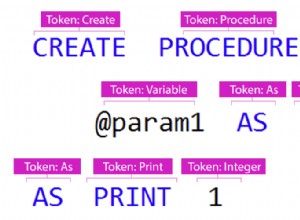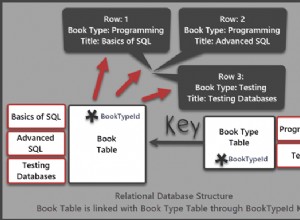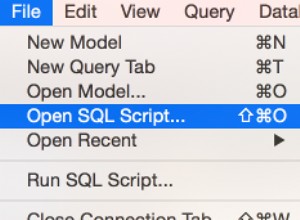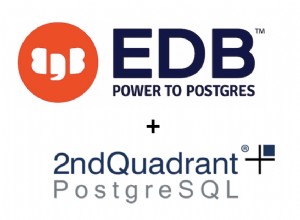एक विकल्प:यह जांचने के लिए लॉजिक को पुश करें कि क्या कोई कॉलम f_log प्रक्रिया में ट्रैक किया जा रहा है और फिर सभी कॉलमों को पार करें।
उदाहरण के लिए, यदि आपके ट्रैक_टेबल में प्रत्येक कॉलम के लिए मान (table_name, column_name, allow) है जिसे आप ट्रैक करना चाहते हैं तो कुछ इस तरह है
CREATE OF REPLACE PROCEDURE f_log( p_id varchar2
,p_table_name varchar2
,p_column_name varchar2
,p_old_val varchar2
,p_new_val varchar2)
as
l_exists number;
cursor chk_column_track IS
SELECT 1
FROM track_TABLE
WHERE upper(TABLE_NAME) = upper(p_table_name)
AND UPPER(column_name) = upper(p_column_name)
AND upper(allow) = 'Y';
begin
open chk_column_track;
fetch chk_column_track into l_exists;
if chk_column_track%found then
--do the insert here
end if;
close chk_column_track;
end;
/
CREATE OR REPLACE TRIGGER trg_TRACK
AFTER INSERT OR UPDATE OR DELETE ON ABC
FOR EACH ROW
DECLARE
n_id varchar(50);
BEGIN
n_id := NVL(:old.id, :new.id);
-- send all of the values to f_log and have it decide whether to save them
f_log(:old.id,'COL1',:old.col1,:new.col1);
f_log(:old.id,'COL2',:old.col2,:new.col2);
f_log(:old.id,'COL3',:old.col3,:new.col3);
...
END;
और भलाई के लिए, अपने ट्रैक_टेबल में मानों को सम्मिलित करने पर अपर-केस करें ताकि आपको UPPER() संग्रहीत मानों की आवश्यकता न हो और इस प्रकार उन मानों पर कोई अनुक्रमणिका बेकार हो जाए!
अब, यह प्रत्येक ऑपरेशन पर प्रत्येक कॉलम नाम की जाँच करने वाले कुछ संसाधनों को चबाएगा, लेकिन यदि आप उच्च-वॉल्यूम नहीं चला रहे हैं तो यह प्रबंधनीय हो सकता है।
अन्यथा आपको अधिक सुरुचिपूर्ण समाधान की आवश्यकता होगी। जैसे संग्रह की शक्ति का लाभ उठाना और TABLE() क्लॉज को ट्रैक_टेबल लुकअप करने के लिए बल्क ऑपरेशन में करना। ध्यान रखें कि मैं इस समय अपने डेटाबेस से दूर हूं, इसलिए मैंने इस कोड का परीक्षण-संकलन नहीं किया है।
CREATE OR REPLACE TYPE t_audit_row AS OBJECT (
p_table_name varchar2(30)
,p_column_name varchar2(30)
,p_id varchar2(50)
,p_old_val varchar2(2000)
,p_new_val varchar2(2000)
);
CREATE OR REPLACE TYPE t_audit_row_table AS TABLE OF t_audit_row;
CREATE OR REPLACE PROCEDURE f_log (p_audit_row_table t_audit_Row_table)
AS
begin
-- see how we can match the contents of the collection to the values
-- in the table all in one query. the insert is just my way of showing
-- how this can be done in one bulk operation. Alternately you could make
-- the select a cursor and loop through the rows to process them individually.
insert into my_audit_log (table_name, column_name, id, old_val, new_val)
select p_table_name
,p_column_name
,p_id
,p_old_val
,p_new_val
FROM track_TABLE TT
,table(p_audit_row_table) art
WHERE tt.TABLE_NAME = art.p_table_name
AND tt.column_name = art.p_column_name
AND tt.allow = 'Y';
end;
/
CREATE OR REPLACE TRIGGER trg_TRACK
AFTER INSERT OR UPDATE OR DELETE ON ABC
FOR EACH ROW
DECLARE
l_id varchar(50);
l_audit_table t_audit_row_table;
BEGIN
l_id := NVL(:old.id, :new.id);
-- send all of the values to f_log and have it decide whether to save them
l_audit_table := t_audit_row_table (
t_audit_row ('ABC','COL1',l_id, :old.col1, :new.col1)
,t_audit_row ('ABC','COL2',l_id, :old.col2, :new.col2)
,t_audit_row ('ABC','COL3',l_id, :old.col3, :new.col3)
,...
,t_audit_row ('ABC','COLn',l_id, :old.coln, :new.coln)
);
f_log(l_audit_table);
end;
/




